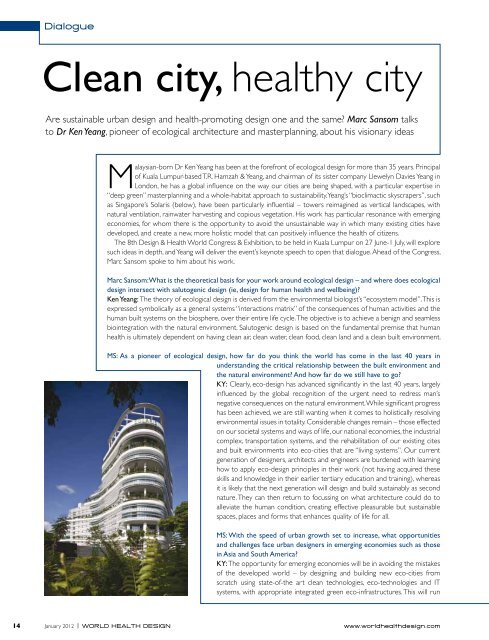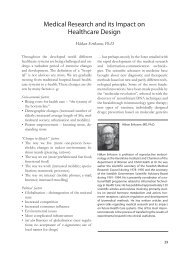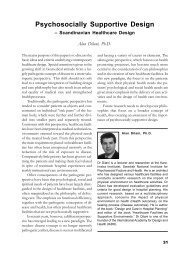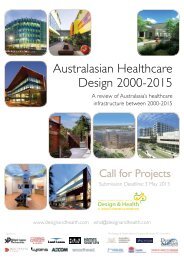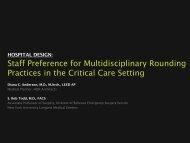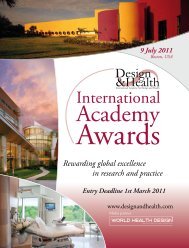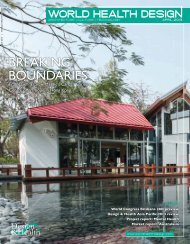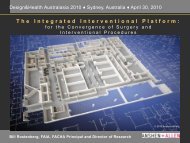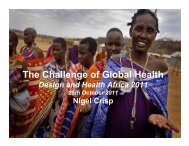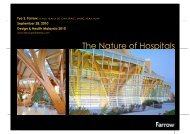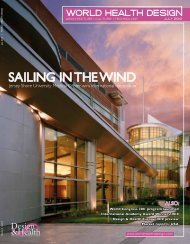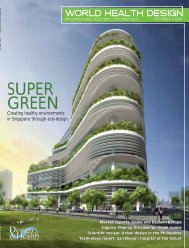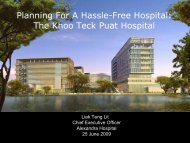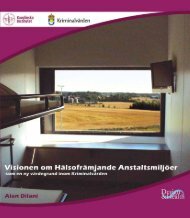RESTORATIVE SpAcE - the International Academy of Design and ...
RESTORATIVE SpAcE - the International Academy of Design and ...
RESTORATIVE SpAcE - the International Academy of Design and ...
Create successful ePaper yourself
Turn your PDF publications into a flip-book with our unique Google optimized e-Paper software.
Dialogue<br />
Clean city, healthy city<br />
Are sustainable urban design <strong>and</strong> health-promoting design one <strong>and</strong> <strong>the</strong> same? Marc Sansom talks<br />
to Dr Ken Yeang, pioneer <strong>of</strong> ecological architecture <strong>and</strong> masterplanning, about his visionary ideas<br />
Malaysian-born Dr Ken Yeang has been at <strong>the</strong> forefront <strong>of</strong> ecological design for more than 35 years. Principal<br />
<strong>of</strong> Kuala Lumpur-based T.R. Hamzah & Yeang, <strong>and</strong> chairman <strong>of</strong> its sister company Llewelyn Davies Yeang in<br />
London, he has a global influence on <strong>the</strong> way our cities are being shaped, with a particular expertise in<br />
“deep green” masterplanning <strong>and</strong> a whole-habitat approach to sustainability. Yeang’s “bioclimactic skyscrapers”, such<br />
as Singapore’s Solaris (below), have been particularly influential – towers reimagined as vertical l<strong>and</strong>scapes, with<br />
natural ventilation, rainwater harvesting <strong>and</strong> copious vegetation. His work has particular resonance with emerging<br />
economies, for whom <strong>the</strong>re is <strong>the</strong> opportunity to avoid <strong>the</strong> unsustainable way in which many existing cities have<br />
developed, <strong>and</strong> create a new, more holistic model that can positively influence <strong>the</strong> health <strong>of</strong> citizens.<br />
The 8th <strong>Design</strong> & Health World Congress & Exhibition, to be held in Kuala Lumpur on 27 June-1 July, will explore<br />
such ideas in depth, <strong>and</strong> Yeang will deliver <strong>the</strong> event’s keynote speech to open that dialogue. Ahead <strong>of</strong> <strong>the</strong> Congress,<br />
Marc Sansom spoke to him about his work.<br />
Marc Sansom: What is <strong>the</strong> <strong>the</strong>oretical basis for your work around ecological design – <strong>and</strong> where does ecological<br />
design intersect with salutogenic design (ie, design for human health <strong>and</strong> wellbeing)?<br />
Ken Yeang: The <strong>the</strong>ory <strong>of</strong> ecological design is derived from <strong>the</strong> environmental biologist’s “ecosystem model”. This is<br />
expressed symbolically as a general systems “interactions matrix” <strong>of</strong> <strong>the</strong> consequences <strong>of</strong> human activities <strong>and</strong> <strong>the</strong><br />
human built systems on <strong>the</strong> biosphere, over <strong>the</strong>ir entire life cycle. The objective is to achieve a benign <strong>and</strong> seamless<br />
biointegration with <strong>the</strong> natural environment. Salutogenic design is based on <strong>the</strong> fundamental premise that human<br />
health is ultimately dependent on having clean air, clean water, clean food, clean l<strong>and</strong> <strong>and</strong> a clean built environment.<br />
MS: As a pioneer <strong>of</strong> ecological design, how far do you think <strong>the</strong> world has come in <strong>the</strong> last 40 years in<br />
underst<strong>and</strong>ing <strong>the</strong> critical relationship between <strong>the</strong> built environment <strong>and</strong><br />
<strong>the</strong> natural environment? And how far do we still have to go?<br />
KY: Clearly, eco-design has advanced significantly in <strong>the</strong> last 40 years, largely<br />
influenced by <strong>the</strong> global recognition <strong>of</strong> <strong>the</strong> urgent need to redress man’s<br />
negative consequences on <strong>the</strong> natural environment. While significant progress<br />
has been achieved, we are still wanting when it comes to holistically resolving<br />
environmental issues in totality. Considerable changes remain – those effected<br />
on our societal systems <strong>and</strong> ways <strong>of</strong> life, our national economies, <strong>the</strong> industrial<br />
complex, transportation systems, <strong>and</strong> <strong>the</strong> rehabilitation <strong>of</strong> our existing cites<br />
<strong>and</strong> built environments into eco-cities that are “living systems”. Our current<br />
generation <strong>of</strong> designers, architects <strong>and</strong> engineers are burdened with learning<br />
how to apply eco-design principles in <strong>the</strong>ir work (not having acquired <strong>the</strong>se<br />
skills <strong>and</strong> knowledge in <strong>the</strong>ir earlier tertiary education <strong>and</strong> training), whereas<br />
it is likely that <strong>the</strong> next generation will design <strong>and</strong> build sustainably as second<br />
nature. They can <strong>the</strong>n return to focussing on what architecture could do to<br />
alleviate <strong>the</strong> human condition, creating effective pleasurable but sustainable<br />
spaces, places <strong>and</strong> forms that enhances quality <strong>of</strong> life for all.<br />
MS: With <strong>the</strong> speed <strong>of</strong> urban growth set to increase, what opportunities<br />
<strong>and</strong> challenges face urban designers in emerging economies such as those<br />
in Asia <strong>and</strong> South America?<br />
KY: The opportunity for emerging economies will be in avoiding <strong>the</strong> mistakes<br />
<strong>of</strong> <strong>the</strong> developed world – by designing <strong>and</strong> building new eco-cities from<br />
scratch using state-<strong>of</strong>-<strong>the</strong> art clean technologies, eco-technologies <strong>and</strong> IT<br />
systems, with appropriate integrated green eco-infrastructures. This will run<br />
14 January 2012 | WORLD HEALTH DESIGN www.worldhealthdesign.com


